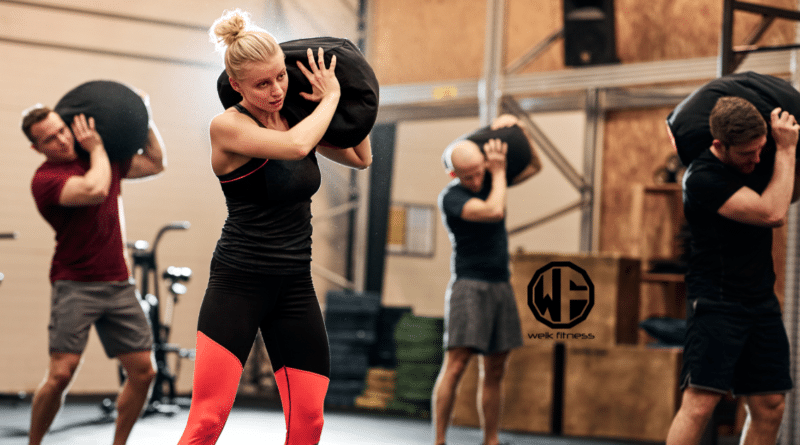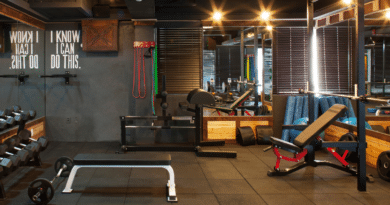Sandbag Workouts: Can Sandbag Training Get You Results?
Searching for a way to spice up your home gym routine? Looking to build muscle but not finding the right connection with traditional weights? Have you considered sandbag workouts?
Probably not, right?
Through exploration, I discovered that sandbag workouts are a brutal way to change up your training. They’re more than just another piece of equipment; they provide a dynamic method for strengthening and toning the entire body.
The shifting weight inside the bag enhances balance and stability — and research backs it up.
In this article, I want to dive deeper and explain how incorporating heavy-duty sandbag workouts into your regimen can transform your fitness journey.
Imagine tackling squats, lunges, and lifts that engage every muscle group while making strength training enjoyable again, putting your core to the test in ways it hasn’t experienced before.
Let’s dig into it!
Table of contents
Key Takeaways
- Sandbag workouts challenge your entire body, making exercises like squats and lunges more effective by engaging multiple muscle groups at once. This method builds functional strength that helps in everyday activities.
- Using sandbags is a versatile and economical way to work out. They don’t take much space, offer a full-body training solution, and their shifting weight improves balance and grip strength over time.
- Any fitness level can start with sandbag training using beginner-friendly exercises. As you get stronger, advanced moves keep the workouts challenging, helping avoid plateaus for continual improvement.
- Comparing traditional weights to sandbags shows that sandbag training can lead to enhanced muscular development due to the instability of the bags, forcing stabilizing muscles to engage more than they would with static weights.
- Designing a personalized workout routine with increasing intensity and incorporating both upper and lower body exercises ensures balanced muscle development while maximizing fat loss and building endurance.
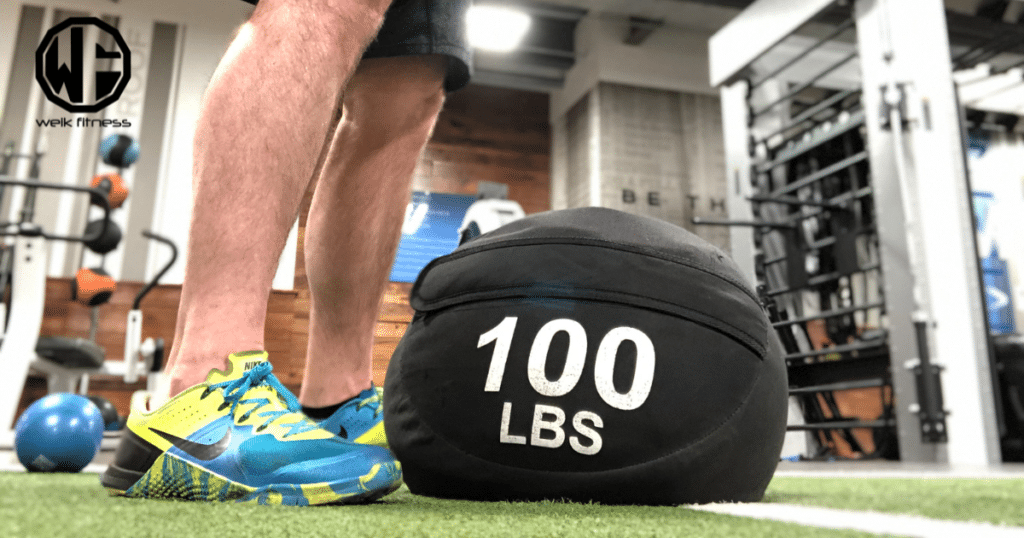
What is Sandbag Training?
Sandbag training is using a heavy bag filled with sand for workouts. It’s like having an entire gym in one piece of equipment. You can do squats, lunges, presses, and deadlifts with it.
These bags are easy to move around, making them perfect for home gyms, garage gyms, and outdoor sessions.
I start with a 30-40 lb bag because that’s good for warming up the body before moving into some heavier set. This type of workout copies real jobs like firefighting or military tasks. It makes you strong in ways lifting dumbbells or barbells doesn’t.
In fact, I did a presentation at a Tremis Dynamics event that Garry Marr held and brought up the fact that doing sandbag workouts would be great for those interested in self-defense and tactics. I explained how heavy sandbags can be used to train for dragging casualties, firemen carrying casualties, etc.
Related Article: Beyond the Gym — Tactical Training for Real-World Preparedness
Overall, sandbag workouts can be extremely beneficial, and you can use your imagination to make them fun. I love how they challenge my whole body and teach me to handle shifting weights, just like in real-life situations.
Key Benefits of Sandbag Workouts
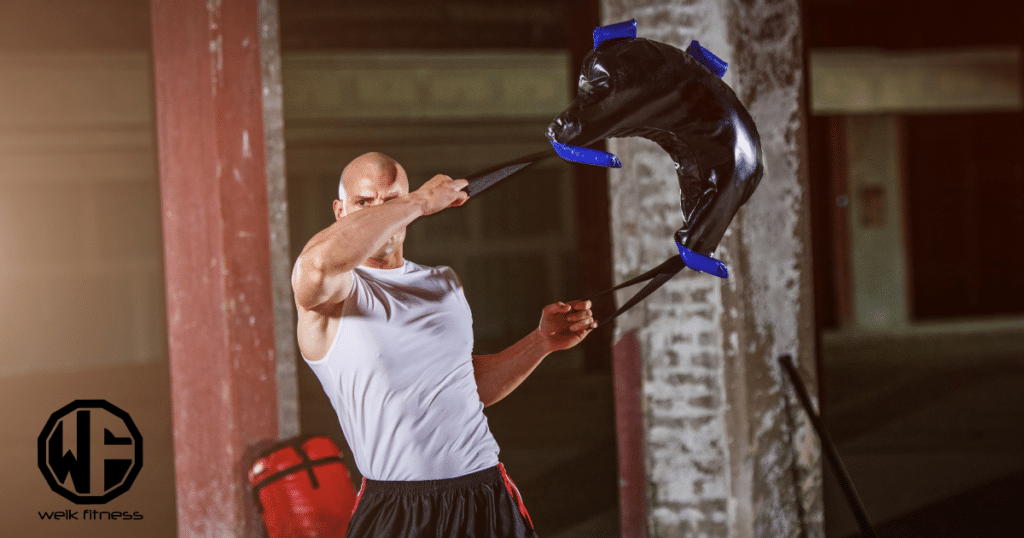
Sandbag workouts offer versatility for full-body training, build functional strength effectively, and are economical and space-efficient. They also enhance grip strength and stamina, making them a well-rounded choice for fitness enthusiasts.
Let’s dive into some of the key benefits of sandbag workouts:
1. Versatility for full-body training
I use a sandbag for a wide range of movements that work my whole body. With just one piece of gear, I can target my legs, upper body, and core. This approach fits perfectly in any home gym where space is at a premium.
Exercises like front squats hit my lower body hard, while overhead presses challenge my shoulders and arms. For core stability, nothing beats the shifting weight of the sandbag during twists and plank pulls (where you pull the sandbag across from one side of you to the other by pulling the sandbag back and forth under you while planking) for a brutal core workout.
Training with this versatile tool doesn’t just build muscle, it prepares me for real-life activities, too. Moving furniture or lifting heavy grocery bags feels much easier now. The instability of the sandbag makes every lift a bit unpredictable, forcing muscles to adapt quickly.
My routine mixes lunges with deadlifts to engage various muscle groups simultaneously — maximizing strength gains without the need for tons of equipment.
2. Builds functional strength effectively
Using sandbags in my workouts has changed how I view strength. Not just any kind of muscle but functional power that makes everyday activities easier. Training with these heavy, shifting sacks forces me to use all my muscles together.
This is different from lifting static weights like dumbbells or barbells (which I still find myself doing more of since I have a full studio at my house). With every lift, pull, and toss of the sandbag, my core tightens, my balance sharpens, and my coordination gets better.

I’ve noticed more improvements in how I move outside the gym, too. Carrying groceries feels lighter, and climbing stairs is faster without getting winded. The unpredictable weight of the sandbag means every part of my body has to work hard to maintain stability and control during exercises like squander lifts or taking it across my back for lunges.
My grip strength has skyrocketed because holding onto a bulky bag requires a lot more effort than gripping a dumbbell handle or barbell. Overall, this style of training prepares me not just for specific tasks but for anything life throws my way — making me stronger in ways I didn’t expect.
3. Economical and space-efficient
Sandbag training and sandbag workouts offer an economical and space-efficient way to enhance your home gym. With minimal investment, sandbags can provide a versatile full-body workout, eliminating the need for costly equipment or extensive space.
Best of all, you can take your sandbag workouts outdoors and enjoy the sun and some natural vitamin D while getting in a brutal workout.
Related Article: The No-Excuse At-Home Resistance Band Workout
These durable bags can be conveniently stored under a bed, in a closet, or in any corner of your garage, making them ideal for those seeking effective workouts without compromising on room availability or budget.
GORUCK sandbags are particularly recommended due to their indestructible design and functional versatility. I love the brand GORUCK but also understand that their stuff can be more on the pricey side.
If you want some great sandbags, you can also check out:
Incorporating these bags into your fitness routine not only saves you money in the long run but also maximizes the use of limited space while delivering powerful results.
Personally, I’ve found that integrating sandbag exercises into my regimen has allowed me to efficiently optimize my workouts without breaking the bank or cluttering my home gym setup with bulky equipment.
4. Enhances grip strength and stamina
Sandbag workouts significantly improve grip strength and stamina due to the diverse ways you can hold and manipulate the sandbag during exercises. This leads to strengthened hand, wrist, and forearm muscles, essential for lifting heavier weights in traditional weight training or excelling in sports such as wrestling or football.
The constantly shifting sand within the bag challenges your grip continuously, promoting endurance while enhancing overall functional strength.
I particularly find that incorporating sandbag workouts into my routine has greatly enhanced my grip strength over time. It’s genuinely remarkable how much more effortless everyday tasks feel with improved grip strength — from opening jars to carrying groceries! It all contributes to an overall improvement in my workout routine.
The Best Sandbag Exercises
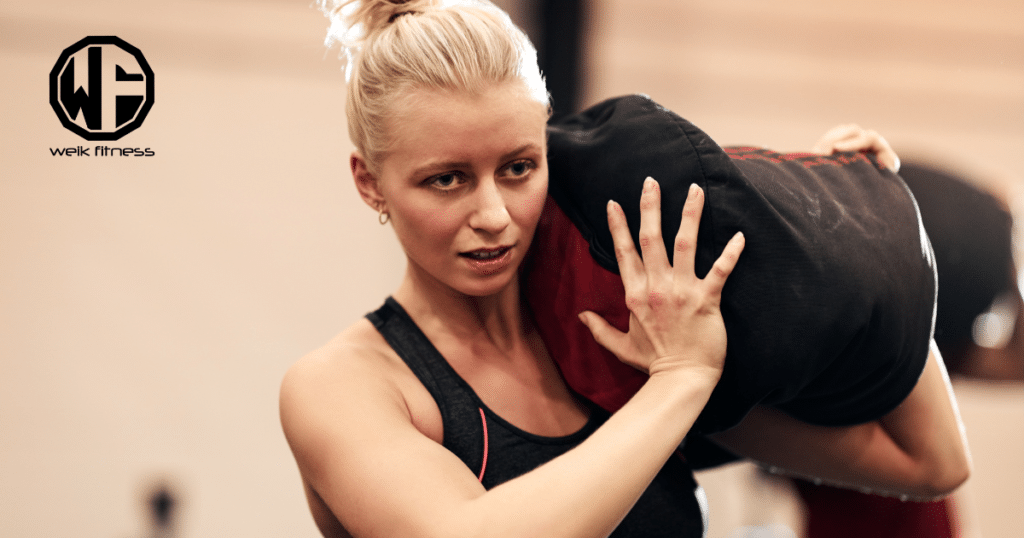
Discover essential sandbag exercises for a full-body workout. Boost versatility, strength, and stamina with the dynamic movements listed below.
1. Sandbag Lunges
Sandbag lunges are a great beginner-friendly exercise that can help target multiple muscle groups, including the glutes, hamstrings, and quads.
When comparing energy expenditure during different weight trials, it was found that sandbag lunges resulted in significantly greater energy expenditure compared to conventional dumbbell trials. This indicates that incorporating sandbag lunges into your workout routine can lead to more effective results in terms of energy spent.
When performing sandbag lunges, focus on maintaining proper form with your core engaged and chest lifted. Stepping forward with one leg at a time while lowering your hips toward the ground will help activate key muscle groups effectively.
Additionally, consider alternating sides to ensure balanced development across both legs for an optimal full-body workout experience when training with this versatile equipment.
2. Sandbag Deadlifts
Incorporating sandbag deadlifts into your training routine is crucial for developing overall strength and muscle mass. The unique movements involved in sandbag deadlifts present a distinctive challenge, contributing to an effective full-body workout.
By integrating sandbag deadlifts (start with the sandbag on the ground), you can elevate the intensity of your strength-building regimen, ensuring comprehensive development across various muscle groups. This exercise proves indispensable for enhancing functional fitness and promoting substantial gains in physical performance.
Sandbag deadlifts target numerous key muscle groups, including the lower back, glutes, hamstrings, and core muscles. Executing this exercise enforces proper lifting techniques while engaging multiple stabilizing muscles concurrently.
As part of my own training experience with home gym equipment, I have found that incorporating sandbag deadlifts has significantly improved my overall strength and endurance. The versatility of this exercise allows for seamless integration into diverse workout routines aimed at fostering robust physical conditioning.
3. Sandbag Presses
Sandbag presses are excellent for building upper body strength and stability. They target the shoulders, chest, and triceps while engaging the core for balance. Hold the sandbag and press it overhead, it challenges multiple muscle groups simultaneously, making it a time-efficient exercise.
Sandbag presses can be modified by altering the weight of the sandbag, allowing for progressive overload to continually challenge your muscles.
Incorporating sandbag presses into your routine provides an opportunity to work on unilateral strength and stability due to the uneven weight distribution of the sand, promoting balanced development in both arms.
Personally, I find that including sandbag presses has significantly enhanced my shoulder stability and overall upper body strength while adding an exciting variation to my workout routine.
4. Sandbag-to-Shoulder
When lifting the sandbag to shoulder height, remember to start with the sandbag on the floor. Hinge at your hips and grip the sandbag securely, then pull it upward in two stages: first from the floor to knee level, then from knee to shoulder.
It’s crucial to use hip extension strength for an effective lift. Maintaining a good position and technique is especially important when dealing with heavier sandbags, ensuring safe and efficient sandbag workouts.
I have found that different techniques are required for lifting lighter versus heavier sandbags. For instance, slower movements with controlled breathing are essential when encountering a heavier load.
This exercise not only builds functional strength effectively but also enhances grip strength and stamina, making it a valuable addition to any home gym routine.
5. Sandbag Get-Up
The sandbag get-up technique activates the core and lats for stability. Engaging with the load creates a better foundation for movement. Using the feet in Ultimate Sandbag exercises leads to better activation of the glutes and core.
Sandbag get-ups teach how to activate your core and lats, ensuring stability during movements. Engaging with the load establishes a strong foundation for fluid movements.
Designing Your Sandbag Workouts
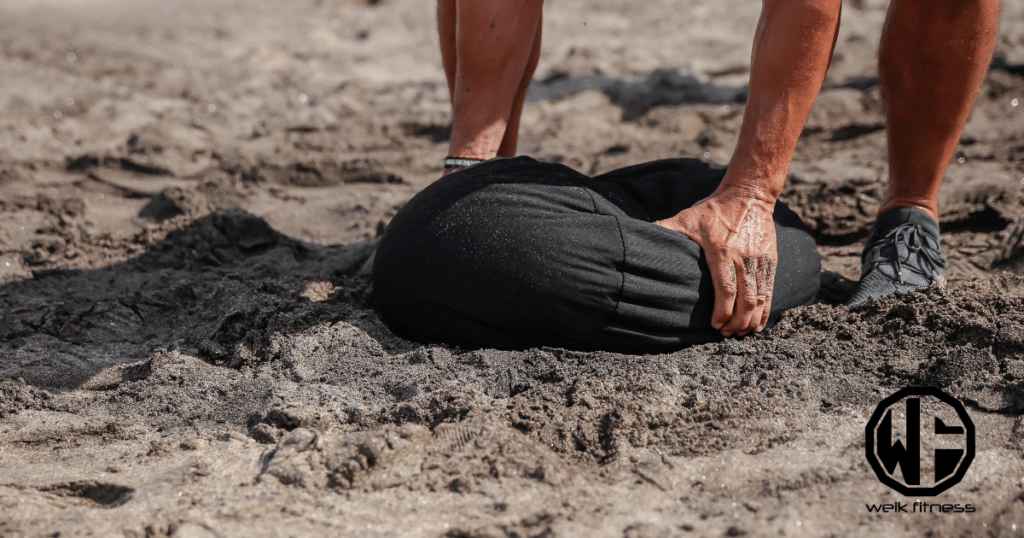
Design a personalized sandbag routine based on your fitness level and goals. Include a mix of beginner-friendly and advanced sandbag exercises for balanced sandbag workouts.
Gradually increase the intensity to challenge yourself and achieve continuous progress.
Beginner-friendly sandbag workouts and exercises
Beginner-friendly exercises with sandbags include forward lunges, back squats, front squats, rows, shoulder presses, and shoulder-to-shoulder presses. It’s important for beginners to warm up thoroughly and gradually build up to working at full intensity.
Sandbag training is affordable and accessible with the option of creating homemade sandbags using old hold-alls or rucksacks filled with builder’s sand.
Advanced sandbag workouts and exercises
Time for advanced sandbag exercises! They include Russian twist, sandbag thrusters, single leg sandbag deadlift, lateral pull + mountain climber, sandbag power clean, sandbag overhead squat, deadlift high pull, and Bradford press.
In this sandbag workout routine, there are no breaks between sets or exercises. Each exercise is done for 45 seconds with a 15-second rest. Expect the whole routine to last just over 30 minutes.
Build more muscle and strength with this 4-days-a-week sandbag training routine!
Tips for sandbag workout progression
To progress in sandbag workouts, increasing the weight used is an effective option. Balancing upper body exercises with lower body workouts maintains form and prevents muscle imbalances.
Including rotational exercises for core stability is crucial. Additionally, a four-day-a-week sandbag training program can be structured to include new and challenging exercises that progressively build strength.
Incorporating these progression tips into your workout routine will help you continually challenge yourself, avoid plateaus, and achieve optimal results from your sandbag training.
I’ve found incorporating these strategies to be highly beneficial and it keeps me motivated and consistently improving my performance.
Comparing the Benefits of Sandbag Training to Traditional Weight Training
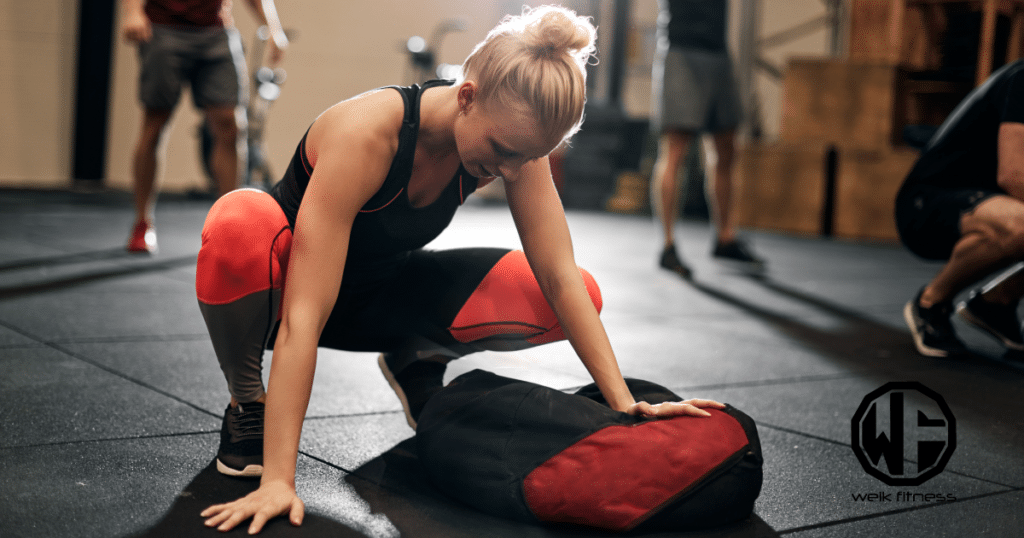
Sandbag training offers versatility and functional strength building, unlike traditional weight training. The exercises engage stabilizing muscles due to the sandbag’s instability.
Sandbags also allow for more natural movements, enhancing overall athleticism.
1. Effectiveness of sandbag workouts in total body muscle building
Sandbag training is highly effective for building muscle strength and size.
According to studies, high-intensity functional training like sandbag workouts has been shown to induce superior muscle-building adaptations compared to traditional weightlifting.
These sandbag workouts not only target specific muscle groups but also engage multiple muscles simultaneously, promoting efficient muscle growth. Sandbag exercises challenge the body in ways that traditional weight training may not, leading to enhanced overall muscular development.
Incorporating sandbag exercises into your routine can lead to significant improvements in both strength and endurance. The dynamic nature of these workouts engages stabilizing muscles, core muscles, and major muscle groups all at once, contributing to a comprehensive approach for maximizing muscle-building potential in home gym settings.
2. Sandbag workout routine frequency and intensity considerations
When planning sandbag workouts, it’s crucial to consider frequency and intensity. I aim for a balanced approach, varying between daily sessions or taking on more challenging routines once a month.
Research has shown that low-volume High-Intensity Functional Training (HIFT) can efficiently enhance aerobic fitness in soldiers. It’s essential to focus on providing adequate training volume and intensity for both strength and endurance exercises.
Engaging in concurrent strength and endurance training with HIFT can lead to superior improvements in aerobic fitness compared to traditional military physical training.
My personal experience working with sandbag workouts has taught me the significance of finding the right balance between frequency and intensity. By following these considerations, you can optimize their workout routine for noticeable results.
Consider Trying Full-Body Sandbag Workouts to Change Up Your Strength Training
Sandbag workouts offer diverse benefits for building strength and endurance. The versatility of sandbag training enables full-body workouts and functional strength development. Training with sandbags is unlike anything you’ll ever do in the gym, kind of like strongman training — it’s great.
Incorporating sandbag exercises into my routine has enhanced my grip strength, core stability, and overall muscular endurance. With its space-saving design and portability, the sandbag is a valuable addition to any home gym setup.
Whether you’re seeking muscle building, fat loss, or overall conditioning, sandbag workouts can elevate your fitness routine with its dynamic and effective training options!
Latest Articles:
- Sirtuins: Key Regulators in Health and Disease Dynamics
- NAD3: Natural NAD Supplement for Cellular Longevity & Energy
- What Makes the Best Electrolyte Supplement for Athletes?


*Disclosure: This article may contain affiliate links or ads, which means we earn a small commission at no extra cost to you if you make a purchase through these links. These commissions help support the operation and maintenance of our website, allowing us to continue producing free valuable content. Your support is genuinely appreciated, whether you choose to use our links or not. Thank you for being a part of our community and enjoying our content.
PLEASE CONSIDER SHARING THIS ON YOUR SOCIAL MEDIA TO HELP OTHERS LEARN MORE ABOUT THIS TOPIC.


